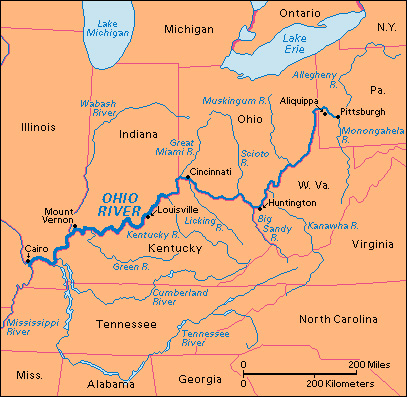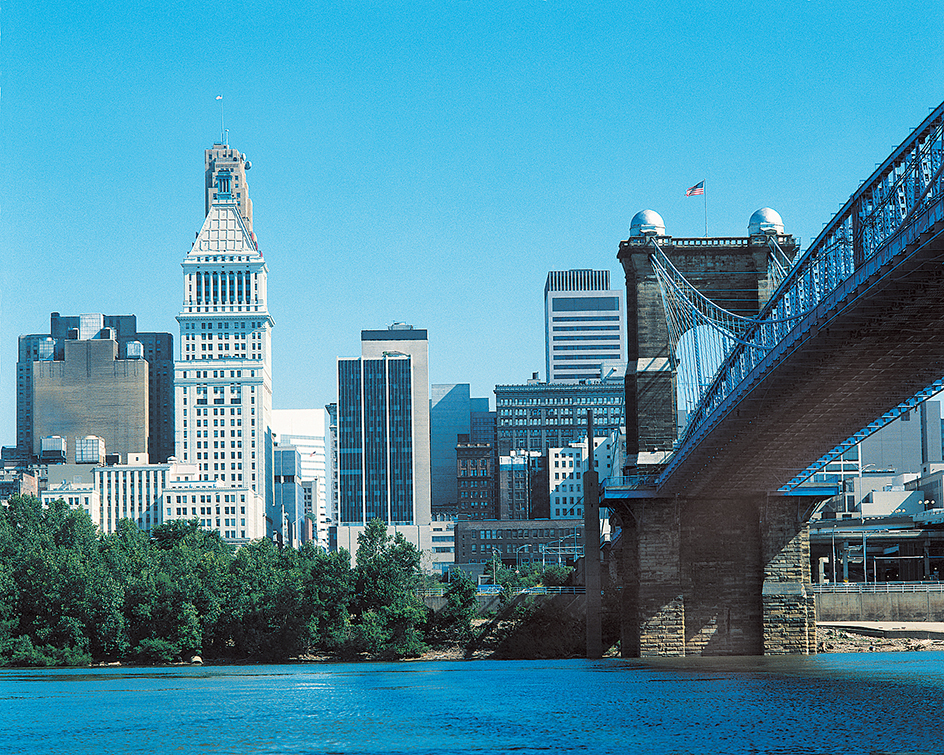Ohio River is the second most heavily used commercial river in the United States. Only the Mississippi River has more cargo shipped on it. The Ohio flows 981 miles (1,579 kilometers) through some of the nation’s busiest industrial regions and richest farmlands. About 200 million tons (180 million metric tons) of freight are transported annually on the Ohio. The river serves some of the country’s principal coal fields and several major steel-producing districts. It drains an area of about 204,000 square miles (528,400 square kilometers).

The Ohio River begins in Pittsburgh, Pennsylvania, where the Allegheny and Monongahela rivers meet. The Ohio flows mainly southwestward and forms the southern borders of Ohio, Indiana, and Illinois, and the northern boundaries of West Virginia and Kentucky. It empties into the Mississippi River at Cairo, Illinois. Major branches of the Ohio include the Muskingum, Kanawha, Big Sandy, Scioto, Licking, Great Miami, Kentucky, Green, Wabash, Cumberland, and Tennessee rivers.
Navigation.
Almost all the cargo transported on the Ohio River moves on large barges. These barges are pushed by tugboats. Dams and canals provide a minimum water depth of 9 feet (2.7 meters). Locks in the canals raise and lower the water level in the river, enabling ships to travel the entire length of the Ohio River. 
Coal is the leading product shipped on the Ohio. Other major cargoes include agricultural products, chemicals, crushed rock, gravel, petroleum products, sand, and steel products. Among the chief ports along the Ohio are Pittsburgh and Aliquippa, Pennsylvania ; Huntington, West Virginia; Cincinnati, Ohio; Louisville, Kentucky ; and Mount Vernon, Indiana.
Animal and plant life.
Forests of beech, hickory, oak, poplar, and sycamore trees cover the Ohio River Valley. Animals in these forests include chipmunks, muskrats, raccoons, red foxes, squirrels, white-tailed deer, and woodchucks. Among the fishes in the Ohio are bullheads, bass, catfish, and trout.
Community and industrial wastes and farming chemicals pollute the Ohio. Pollution threatens fish and other wildlife. The Ohio River Valley Water Sanitation Commission regulates the release of river pollutants.
History.
In 1669, the French explorer René-Robert Cavelier, Sieur de La Salle, became the first European to see the Ohio River. At that time, Shawnee and other Indians lived along its shores. Throughout the 1700’s, traders used the river to explore the entire Ohio River Valley. Settlers traveled on the Ohio to the Northwest Territory after that region was established in 1787.
More than 60 steamboats were active on the Ohio by 1820. After the American Civil War ended in 1865, the river became a major corridor for the shipment of raw materials and industrial products. During the early 1900’s, the steamboats were gradually replaced by powerful tugboats pushing heavy barges.
Flooding along the Ohio often causes heavy damage. Severe floods in 1937, 1945, and 1963 brought great losses of life and property. Since the 1950’s, the federal government has worked with the states bordering the river to build or update about 20 dam and canal structures that control most flooding on the Ohio.
